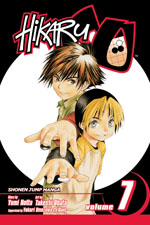 Written by Yumi Hotta
Written by Yumi Hotta
Art by Takeshi Obata
216 pages, black and white
Published by Viz
One of the biggest problems with what I’ve started calling in my head “tournament comics” is that I can never read them for too long. Essentially, it’s a comic where the protagonist is going through a series of competitions, be it soccer, tennis, go, cooking, or even something like fighting ninjas or evil demons. Sooner or later, the comic always seems to fall into a rut where it’s yet another bad guy with an even bigger and tougher finishing move and our hero has to fight them against all odds and figure out just how to win yet again. That’s why when reading the latest volume of Hikaru no Go I found myself genuinely excited, because I think it’s one of the few books with this basic set-up that successfully avoids falling into that trap.
Hikaru Shindo is now at insei school, where he’s getting to play go against all sorts of students. The only problem is, he’s losing all of his matches and badly. Can Hikaru really play go well enough without the spirit of Sai helping him out? And how can he ever go up against Akira Toya if he can’t win against his fellow students?
Yumi Hotta gets a lot of credit from me for really understanding her audience and writing a book that will keep them interested. It would be easy to assume that readers of Hikaru no Go want to see the latest go move as Hikaru solves a new strategy. That’s not what Hotta does, though. Instead, she broadened the subject matter to more general terms that a wider cross-section of readers will understand. We don’t need to know that Hikaru plays a bad move at coordinates 23-by-11 that is against a classic go strategy; instead what we need to know is that Hikaru makes a bad move that he then against all odds transforms into a good one through his own unique game play. The concentration isn’t specific go moves, it’s how Hikaru grows more confident not only as a player of go but as a person in general, able to pull himself up through the ranks through sheer talent and determination. It’s something that everyone can understand without needing to know the specific mechanics of the game. At the same time, I’ve got no doubt that people who do really understand go will be nodding in comprehension as the story progresses, but go is really the stage for Hikaru’s story instead of the exclusive focus. It’s an important distinction that Hotta really understands.
Of course, this wouldn’t matter at all if it wasn’t for the fact that Hikaru is a genuinely likable character. He tries hard, sometimes he fails, other times he succeeds, but he’s got a good attitude through it all. He doesn’t always do the right thing, but he’s the sort of guy who really does learn from his mistakes on both a professional and personal level. There’s also a fun supporting cast, from his school club players that he left behind (and I love that Hotta doesn’t forget about them) and his new friends-and-opponents at the insei school; to the 9 Dan instructor interested in Hikaru’s abilities, and Hikaru’s greatest rival and future opponent Akira Toya. They keep the story bright and interesting, and I actually found myself caring about them as much as Hikaru himself.
It’s interesting to read volumes of Hikaru no Go and Death Note back-to-back, both drawn by Takeshi Obata, because it gives you a greater appreciation for the work he does to make his art fit the story. Obata always has some characteristics on display, such as a strong eye for anatomy and panel-to-panel progression across the page. While Obata’s art is dark and sinister for Death Note, though, it’s much different in the pages of Hikaru no Go. Here we see a high level of exuberance and energy; Hikaru’s enthusiasm is so infectious in part thanks to Obata’s drawings, with his glee and excitement so evident on the page. Obata’s able to make Hikaru’s snapping down of a go tile energetic, because not only can you see the force of the movement, but through Hikaru’s body language how much playing go actually means to Hikaru. Most comics in Japan that I’ve seen have been written and drawn by the same person, so it makes me happy to see such a strong pairing of a writer and artist from a place that it seems to be more of the exception that the rule; a reminder that you really can find two creators who are completely on the same wavelength in their creation of a great comic.
Seven volumes in, Hikaru no Go is just as much a joy to read as when it first debuted. Hotta and Obata have done an excellent job of keeping the book from falling into a rut, instead focusing less on the skills and much more about the person learning them. By avoiding the trap of concentrating on the opponents and the moves, and making the reader genuinely care about Hikaru, they’ve played a perfect game of their own. Don’t be afraid that you don’t know anything about the game of go, you don’t need to. Just make sure you check this book out.
Purchase Links:
